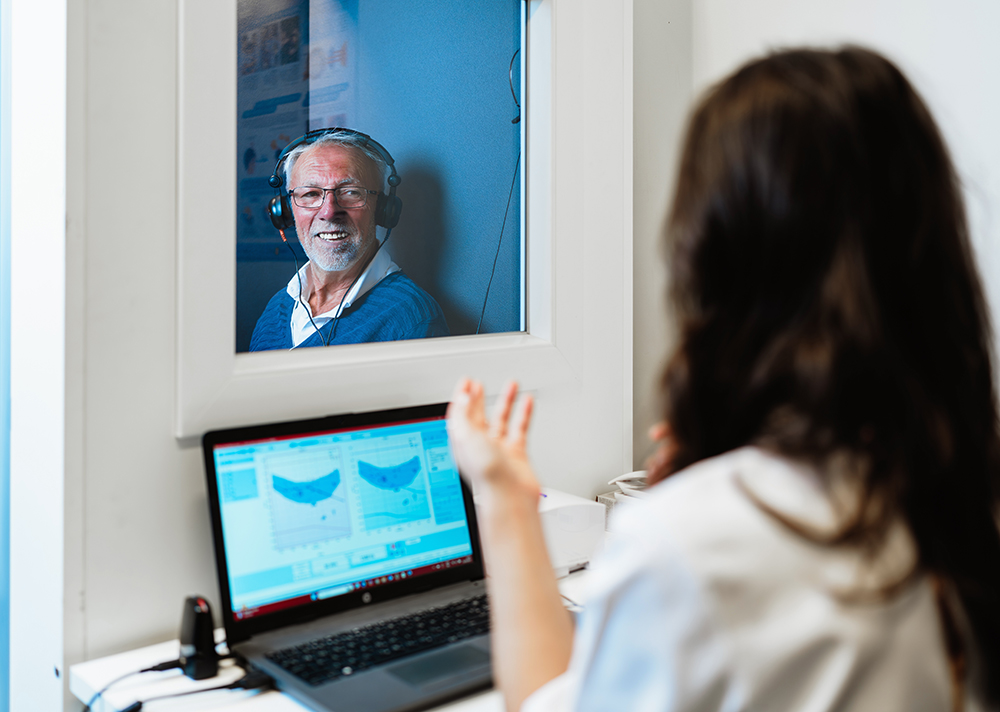The Role of Hearing Tests in Preventative Health Care
Hearing tests are an important part of preventative health care, yet many
New Location Now Open in Fort Mitchell! LEARN MORE →

By: Vanessa Ewert, Au.D, LIC.-A | January 26, 2025
Technology continues to evolve, and its impact on hearing care is no exception. One emerging tool in this field is virtual reality (VR). While VR was initially popularized for gaming and entertainment, it is now being used in healthcare settings to offer new ways of managing hearing loss. From conducting assessments to providing rehabilitation and training, VR is opening up new possibilities for improving hearing care and making it more accessible to those who need it.
Virtual reality is a technology that creates a three-dimensional, computer-generated environment that users can experience and interact with as if it were real. By wearing a specialized headset, you can look around and even move within these virtual spaces, often using controllers to interact with objects or navigate through the simulated world. VR provides an immersive experience that goes beyond watching a screen, allowing you to engage with digital environments in a hands-on way.
When it comes to hearing rehabilitation, VR offers unique opportunities to practice and improve listening skills in controlled, realistic settings. You could find yourself virtually placed in a busy coffee shop or a bustling train station, where background noise and conversations mirror real-world situations. These scenarios can help you practice distinguishing sounds, following conversations and adapting to challenging auditory environments – all in a safe and customizable space designed to build your confidence and skills.
Virtual reality (VR) is becoming a useful tool in the medical field, offering new ways to improve healthcare. In surgical training, VR allows doctors to practice complex procedures in a simulated environment. It also plays a role in physical therapy, providing interactive exercises tailored to the needs of each patient. In hearing healthcare, VR is being explored for its potential to support individuals with hearing loss. One application is auditory training, where VR creates realistic environments like busy streets or noisy restaurants. These scenarios give people the chance to practice listening and understanding speech in situations they might encounter in daily life. For those adjusting to devices like hearing aids, VR can help ease the transition by providing a safe space to work on their auditory skills.
VR may also offer emotional benefits in hearing care. Coping with hearing loss can sometimes bring stress, and VR could provide calming environments or mindfulness exercises to promote relaxation. These applications show how VR is being adapted to address both practical and emotional aspects of hearing care. While it’s still a developing area, VR is proving to be a valuable addition to healthcare strategies.
Hearing loss can be managed in a variety of ways, depending on the severity of your hearing loss. Hearing aids amplify sounds, making it easier for people to hear conversations and other important sounds in their environment. Hearing aids come in different styles and can be customized to suit individual preferences. An audiologist can help determine the best option for each person’s needs.
While virtual reality can’t directly treat hearing loss, it offers valuable tools for managing and improving hearing health. By simulating realistic soundscapes, VR allows individuals to practice listening in different environments, like a busy restaurant or a crowded street. These virtual experiences can help people with hearing loss improve their ability to recognize sounds and understand speech in challenging situations. Unlike traditional methods of auditory training, VR offers an immersive way to engage both the ears and the brain, potentially making the process more adaptable to real-world scenarios.
VR can offer support in therapies designed to manage hearing-related challenges, like tinnitus or auditory processing disorders. For instance, calming virtual environments may help ease some of the stress linked to these conditions. VR can also be included in educational programs for those adjusting to hearing aids or assistive listening devices, helping wearers become more familiar with the devices in a practical, interactive way. Although VR doesn’t directly treat hearing loss, its role as a helpful tool in hearing care continues to expand as technology improves.
Virtual reality in hearing rehabilitation has multiple benefits. It offers a unique platform for practicing listening skills in various realistic scenarios, greatly improving your ability to understand speech amidst noise. Additionally, it provides a safe environment for training your ears without the risk of further damage from excessive noise exposure. Importantly, it adds an element of enjoyment into the rehabilitation process, making auditory exercises more engaging and less overwhelming.
VR can also support a smoother transition to using hearing aids or assistive devices by gradually introducing you to more challenging listening environments. Instead of immediately facing real-world situations that might feel difficult to manage, VR allows you to practice adjusting to different sounds and settings in a controlled space. This approach can help reduce stress while giving you the chance to become more comfortable and skilled with your devices over time. By building confidence in a low-pressure way, VR can make integrating hearing aids into your daily life a more manageable process.
While VR offers several benefits, there are a few things to consider before jumping in. It requires specific equipment, like headsets and may take some time to get used to, especially for those who aren’t very familiar with technology. Not everyone may feel completely comfortable using these tools right away. Also, since research into the long-term effects of regular VR use is still in progress, it’s a good idea to stay up-to-date with the information on virtual reality.
For some individuals, using VR for hearing rehabilitation could be difficult, especially if they experience balance issues. Wearing the VR headset for extended periods might make them feel dizzy or disoriented. While VR has its benefits, it’s important to consider personal health factors, like balance and decide if this approach is the right one based on individual needs.
Virtual reality offers the ability to tailor hearing rehabilitation experiences to each individual’s unique needs. Since hearing loss affects everyone differently, this customization can help address specific challenges. If understanding speech in noisy settings is difficult, the virtual training can focus on those types of environments. As you progress, the complexity and difficulty of the exercises can be adjusted to match your improvements, ensuring that the training remains relevant to your needs. Here are some key aspects of this personalized auditory training:
Virtual reality tools offer the ability to track and monitor your progress as you work through hearing rehabilitation exercises. These tools often include features that provide feedback based on your performance, allowing you to see how well you’re improving over time. VR systems might track how effectively you can identify different sounds or follow conversations in noisy environments. This progress tracking helps you understand which areas need more focus.
In addition, many VR tools allow you to adjust the level of difficulty in your exercises, based on how well you’re doing. These gradual adjustments make it easier to stay engaged and avoid frustration. By monitoring your own progress, you gain a clearer sense of how your hearing skills are developing, which can lead to more confidence in managing real-world situations.
If you’re considering virtual reality as a treatment option for hearing-related challenges, it’s a good idea to discuss it with your audiologist. They can help you understand how VR might complement your current treatment plan and whether it’s suitable for your needs. Audiologists are knowledgeable about different therapies and can explain the potential benefits of using VR, like improving auditory skills or helping you adjust to new hearing aids. They can also guide you in selecting the right VR tools or training programs that would work best for you.
Talking to your audiologist about VR ensures that you’re making an informed decision. They can also monitor your progress as you use VR, making adjustments if necessary to ensure you’re getting the most out of your experience. With their support, you can make sure that any new treatment options fit well with your goals for managing hearing loss and improving overall hearing health.
The future of virtual reality in hearing healthcare looks promising as it continues to evolve. With ongoing advancements in VR technology, it may offer new ways to support individuals with hearing loss beyond training and rehabilitation. For example, VR could be used to create more dynamic environments for social situations, allowing people to practice real-life interactions in virtual spaces. This could help individuals build confidence and feel more comfortable in social settings, where hearing challenges are often most noticeable.
Additionally, VR could be integrated with other healthcare services to provide a more comprehensive approach to managing hearing loss. As virtual reality becomes more accessible, it could allow audiologists to remotely monitor progress and adjust treatments in real time, offering a more flexible and personalized experience for patients. This integration of VR into hearing healthcare could make it easier for individuals to stay engaged with their treatment and track improvements over time. With the continued development of VR technology, there is great potential for it to play an important role in hearing healthcare in the future.
Virtual reality provides a practical and innovative way to support auditory health. While new technology may seem unfamiliar, it’s simply a matter of understanding how these tools can assist in improving hearing and managing challenges.
Virtual reality has the potential to change how you experience everyday situations by simulating real-life environments and offering feedback to. This could lead to improvements in your overall quality of life. While everyone’s hearing needs are different, it is important to talk with an audiologist to guide you through the process and find the right treatment for your specific needs.
If you want to learn more about virtual reality tools for hearing or learn more about how to manage your hearing loss to improve your quality of life don’t hesitate to contact Bluegrass Hearing Clinic. You can call us at (859) 295-5729. Our team is ready to assist you at any of our convenient offices in Bardstown, Danville, Elizabethtown, Frankfort, Lexington, Mount Sterling, Nicholasville, Paris, Richmond and Somerset, KY.

Hearing tests are an important part of preventative health care, yet many
By: Vanessa Ewert, Au.D, LIC.-A | November 18, 2025

Living with tinnitus means dealing with sounds that only you can hear,
By: Vanessa Ewert, Au.D, LIC.-A | October 3, 2025

When you’re getting your hearing tested, you might be surprised by
By: Vanessa Ewert, Au.D, LIC.-A | September 24, 2025
